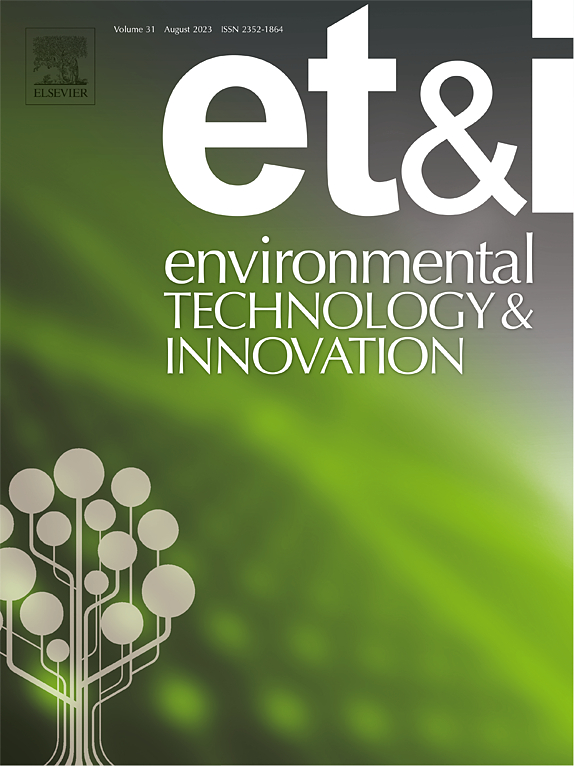Spatio-temporal influencing effects and mechanisms of the digital economy on eco-urbanization in the Yangtze River Delta region
IF 6.7
2区 环境科学与生态学
Q1 BIOTECHNOLOGY & APPLIED MICROBIOLOGY
引用次数: 0
Abstract
The digital economy (DIGE) plays a crucial role in advancing the sustainable development of the urban ecological environments. This study explored the co-evolutionary dynamics between DIGE and eco-urbanization (ECU), and investigates the impact mechanisms of DIGE on ECU in the Yangtze River Delta (YRD) region. The following findings include: (1) The coupling coordination between DIGE and ECU increased from 2011 to 2021, with higher coordination observed in the developed central delta region and lower levels in less developed areas of Anhui and northern Jiangsu. (2) A positive and intensifying relationship emerged between DIGE and ECU during this period, with most cities in the delta region showing positive correlations. Higher incidence intensity was found in developed cities in southern Anhui, and central and southern Jiangsu, while weaker incidence intensity was observed in the less developed northern Anhui, northern Jiangsu, as well as western Zhejiang. (3) A significantly positive spatial association was identified, characterized by stable local transfer inertia and lock-in effects. The LDIGELECU type cities were primarily located in the less developed northern delta and parts of relatively developed central Anhui and Jiangsu; notably, the HDIGEHECU type cities were clustered in the developed southeastern delta region. (4) DIGE not only promoted ECU directly, but also indirectly advanced it through green technological innovation, industrial ecologization, industrial structural optimization, and environmental regulations. Furthermore, synergistic promotion, feedback effects, and mutual spatial spillover effects were identified between DIGE and ECU. Understanding these patterns and mechanisms is essential for guiding policy actions and fostering sustainable urban development.
数字经济(DIGE)在推动城市生态环境可持续发展方面发挥着至关重要的作用。本研究探讨了数字经济(DIGE)与生态城市化(ECU)之间的协同演化态势,研究了数字经济(DIGE)对长三角地区生态城市化的影响机制。研究结果包括(1)从 2011 年到 2021 年,DIGE 与 ECU 之间的耦合协调性增强,三角洲中部发达地区的协调性较高,而安徽和江苏北部欠发达地区的协调性较低。(2) 在此期间,DIGE 和 ECU 之间出现了正相关且不断加强的关系,三角洲地区的大多数城市都呈现出正相关。安徽南部、江苏中部和南部的发达城市发病强度较高,而欠发达的安徽北部、江苏北部和浙江西部的发病强度较弱。(3) 发现了明显的正空间关联,其特点是稳定的局部转移惯性和锁定效应。LDIGELECU 型城市主要分布在欠发达的北部三角洲以及相对发达的安徽中部和江苏的部分地区;值得注意的是,HDIGEHECU 型城市主要聚集在发达的东南三角洲地区。(4) DIGE 不仅直接促进了 ECU 的发展,还通过绿色技术创新、产业生态化、产业结构优化和环境监管间接推动了 ECU 的发展。此外,还发现了 DIGE 与 ECU 之间的协同促进、反馈效应和相互空间溢出效应。了解这些模式和机制对于指导政策行动和促进城市可持续发展至关重要。
本文章由计算机程序翻译,如有差异,请以英文原文为准。
求助全文
约1分钟内获得全文
求助全文
来源期刊

Environmental Technology & Innovation
Environmental Science-General Environmental Science
CiteScore
14.00
自引率
4.20%
发文量
435
审稿时长
74 days
期刊介绍:
Environmental Technology & Innovation adopts a challenge-oriented approach to solutions by integrating natural sciences to promote a sustainable future. The journal aims to foster the creation and development of innovative products, technologies, and ideas that enhance the environment, with impacts across soil, air, water, and food in rural and urban areas.
As a platform for disseminating scientific evidence for environmental protection and sustainable development, the journal emphasizes fundamental science, methodologies, tools, techniques, and policy considerations. It emphasizes the importance of science and technology in environmental benefits, including smarter, cleaner technologies for environmental protection, more efficient resource processing methods, and the evidence supporting their effectiveness.
 求助内容:
求助内容: 应助结果提醒方式:
应助结果提醒方式:


